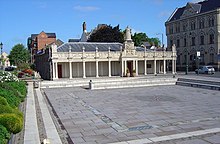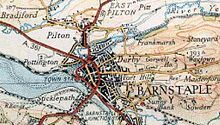Welcome to Visit Barnstaple Places
The Walkfo guide to things to do & explore in Barnstaple
![]() Visit Barnstaple places using Walkfo for free guided tours of the best Barnstaple places to visit. A unique way to experience Barnstaple’s places, Walkfo allows you to explore Barnstaple as you would a museum or art gallery with audio guides.
Visit Barnstaple places using Walkfo for free guided tours of the best Barnstaple places to visit. A unique way to experience Barnstaple’s places, Walkfo allows you to explore Barnstaple as you would a museum or art gallery with audio guides.
Visiting Barnstaple Walkfo Preview
Barnstaple is at the lowest crossing point of the River Taw flowing into the Bristol Channel. From the 14th century, it was licensed to export wool, but its harbour silted up and other industries developed. The parish had a population of 24,033 at the 2011 census, and the built-up area of 32,411 in 2018. When you visit Barnstaple, Walkfo brings Barnstaple places to life as you travel by foot, bike, bus or car with a mobile phone & headphones.
Barnstaple Places Overview: History, Culture & Facts about Barnstaple
Visit Barnstaple – Walkfo’s stats for the places to visit
With 41 audio plaques & Barnstaple places for you to explore in the Barnstaple area, Walkfo is the world’s largest heritage & history digital plaque provider. The AI continually learns & refines facts about the best Barnstaple places to visit from travel & tourism authorities (like Wikipedia), converting history into an interactive audio experience.
Barnstaple history
Pilton is recorded in the Burghal Hidage (c. 917) as a burh founded by Alfred the Great. The town’s wealth in the Middle Ages was founded on it being a staple port licensed to export wool. In the early 14th century it was Devon’s third richest town after Exeter and Plymouth.
Barnstaple toponymy
The spelling Barnstable is obsolete, but retained by an American county and city. It is thought to derive from the Early English bearde, meaning “battle-axe”, and stapol. The belief that the name comes from staple meaning “market”, indicating a market here from the foundation of the settlement.
Barnstaple landmarks

St Anne’s Chapel in the central churchyard is the most important of the ancient buildings to survive. Queen Anne’s Walk was erected in about 1708 as a mercantile exchange. Georgian Guildhall is also of interest, as is the Pannier Market beneath it.
Barnstaple Castle

A wooden castle was built by Geoffrey de Mowbray, Bishop of Coutances in the 11th century. Juhel of Totnes later occupied the castle and founded Barnstaple Priory just outside its walls. The castle’s first stone buildings were probably erected by Henry de Tracey, a supporter of King Stephen.
St Anne’s Chapel
Grade II listed St Anne’s Chapel was restored in 2012 and used as a community centre. It was an ancient Gothic chantry chapel whose assets were acquired by the Mayor of Barnstaple and others in 1585.
Pannier Market and Butchers’ Row

Barnstaple has been the major market for North Devon since Saxon times. Demands for health regulation of its Victorian food market saw the construction in 1855–1856 of a Pannier Market, originally known as the Vegetable Market. Built on the other side of the street, Butchers’ Row consists of ten shops with pilasters of Bath Stone and wrought-iron supports.
Others
Barnstaple is home to the largest crematorium in England, Wales and Northern Ireland. The South West Coast Path National Trail runs through the town and gives access to walks along the spectacular North Devon coast.
Barnstaple geography / climate

Barnstaple, the main town of North Devon, claims to be the oldest borough in the United Kingdom. It was founded at the lowest crossing point of the River Taw, where its estuary starts to widen. The town’s early medieval layout still appears from the street plan and street names, with Boutport Street following the curved line of the ditch outside the town walls.
Climate
Barnstaple has cool wet winters and mild wet summers. October is the wettest month with 103 mm (4.1 in) of rain. The mean annual rainfall is 862 mm (33.9 in), with rain on 138 days.
Why visit Barnstaple with Walkfo Travel Guide App?
![]() You can visit Barnstaple places with Walkfo Barnstaple to hear history at Barnstaple’s places whilst walking around using the free digital tour app. Walkfo Barnstaple has 41 places to visit in our interactive Barnstaple map, with amazing history, culture & travel facts you can explore the same way you would at a museum or art gallery with information audio headset. With Walkfo, you can travel by foot, bike or bus throughout Barnstaple, being in the moment, without digital distraction or limits to a specific walking route. Our historic audio walks, National Trust interactive audio experiences, digital tour guides for English Heritage locations are available at Barnstaple places, with a AI tour guide to help you get the best from a visit to Barnstaple & the surrounding areas.
You can visit Barnstaple places with Walkfo Barnstaple to hear history at Barnstaple’s places whilst walking around using the free digital tour app. Walkfo Barnstaple has 41 places to visit in our interactive Barnstaple map, with amazing history, culture & travel facts you can explore the same way you would at a museum or art gallery with information audio headset. With Walkfo, you can travel by foot, bike or bus throughout Barnstaple, being in the moment, without digital distraction or limits to a specific walking route. Our historic audio walks, National Trust interactive audio experiences, digital tour guides for English Heritage locations are available at Barnstaple places, with a AI tour guide to help you get the best from a visit to Barnstaple & the surrounding areas.
“Curated content for millions of locations across the UK, with 41 audio facts unique to Barnstaple places in an interactive Barnstaple map you can explore.”
Walkfo: Visit Barnstaple Places Map
41 tourist, history, culture & geography spots
Barnstaple historic spots | Barnstaple tourist destinations | Barnstaple plaques | Barnstaple geographic features |
| Walkfo Barnstaple tourism map key: places to see & visit like National Trust sites, Blue Plaques, English Heritage locations & top tourist destinations in Barnstaple | |||
Best Barnstaple places to visit
Barnstaple has places to explore by foot, bike or bus. Below are a selection of the varied Barnstaple’s destinations you can visit with additional content available at the Walkfo Barnstaple’s information audio spots:

Holy Trinity Church, Barnstaple
Holy Trinity is an Anglican parish church for Barnstaple in Devon. Dating from 1867 with an earlier tower from 1843 to 1845, the church comes under the Diocese of Exeter and has been Grade II* listed building since 1981.
Penrose’s Almshouses
Penrose’s Almshouses are 17th-century almshouses in Litchdon Street, Barnstaple, in Devon, built in memory of John Penrose (1575–1624) They have been a Grade I listed building since 1951.

Museum of Barnstaple and North Devon
Museum of Barnstaple and North Devon covers the history and culture of the North Devon area. The displays range from prehistoric times to Victorian era. The building and its garden railings beside the river front have been Grade II listed since 1988.

St Peter’s Church, Barnstaple
St Peter’s Church is the parish church of Barnstaple in North Devon. The church dates back to the 13th-century with much restoration during the Victorian era by George Gilbert Scott and his son John Oldrid Scott.

Newport, Devon
Newport is one mile south-east of the historic centre of Barnstaple. It is situated on the east side of the River Taw. Few ancient buildings survive, the “Old Dairy” being a notable exception.

Rock Park
Rock Park was donated to the public by William Frederick Rock and opened in 1879. It has a number of listed structures including an obelisk at the entrance to the park.

Guildhall, Barnstaple
The Guildhall in Barnstaple in Devon was completed in 1828. Beneath and behind the Guildhall is the Pannier Market. The building has been a Grade II* listed building since 1951.

Queen Anne’s Walk
Queen Anne’s Walk (formerly The Mercantile Exchange) is a grade I listed building in Barnstaple, North Devon. It was completed in 1713 as a meeting place for the town’s merchants. It is believed to have been designed by the architect William Talman, on the basis of its similarity to his work at the Hall in Drayton.

Pilton House, Pilton
Pilton House in the parish of Pilton, near Barnstaple, North Devon, Ex31. Grade II listed Georgian mansion house built in 1746 by Robert Incledon (1676-1758)

North Devon District Hospital
North Devon District Hospital is an NHS district general hospital in the town of Barnstaple, North Devon. It is run by Northern Devon Healthcare NHS Trust.
Visit Barnstaple plaques
![]() 0
0
plaques
here Barnstaple has 0 physical plaques in tourist plaque schemes for you to explore via Walkfo Barnstaple plaques audio map when visiting. Plaques like National Heritage’s “Blue Plaques” provide visual geo-markers to highlight points-of-interest at the places where they happened – and Walkfo’s AI has researched additional, deeper content when you visit Barnstaple using the app. Experience the history of a location when Walkfo local tourist guide app triggers audio close to each Barnstaple plaque. Currently No Physical Plaques.

